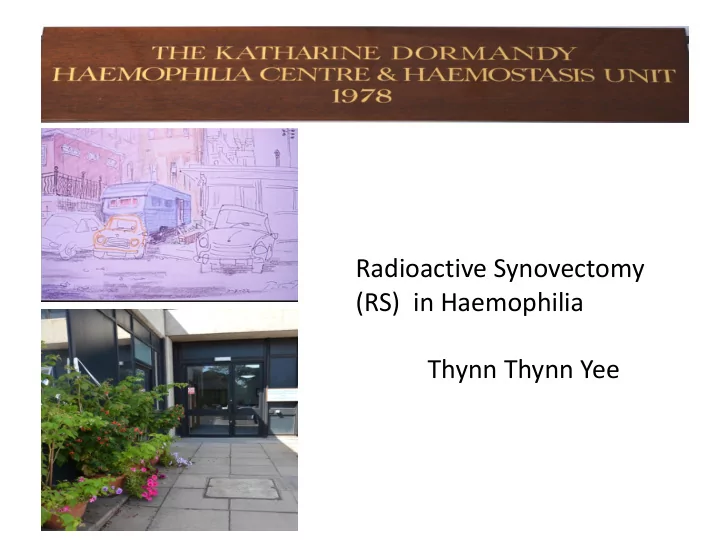

Radioactive Synovectomy (RS) in Haemophilia Thynn Thynn Yee
RS • Local form of radionuclide therapy • Removal of the synovial membrane by intra-articular application of radioisotopes • RS therapy has been used in Rheumatoid Arthritis since 1950s • RS using Gold therapy in haemophilia was first used in Sweden by Dr Ahlberg in 1977
Haemophiliac arthropathy pathogenesis (ref 1)
Radioactive synovectomy Hypertrophic and highly vascular synovium Intra-aricular injection of radioisotope Fibrosed and Sclerotic and poorly vascularised tissue Phagocytosis by the macrophages of the synovium of the radio isotope Beta radiation causes coagulation necrosis, fibrosis of synovial cells, vessels and pain receptors
Suitable candidates • Haemophilia A and B individuals with inhibitors and target joints • HA and HB individuals without inhibitors who have unresolved repeated intra- articular bleeds • Best done before cartilage and joint damage • USG or MRI prior to therapy • Absolute Contraindications – Massive haemarthrosis – Septic local infection – Presence of ruptured baker’s cyst • Relative Contraindications – Joint instability – Severe cartilage destruction
Ideal Radiopharmaceuticals • Pure beta emitter • Limited range of tissue penetration • Moderate Physical half life • Colloidal form-to achieve optimal synovial distribution • Yttrium half life is is 2.8 days and therapeutic tissue penetration is 3.6 mm • Rhenium half life is 3.8 days and therapeutic tissue penetration is 1 mm • Ytrium used only for knees • Rhenium can be used for elbow, ankles, shoulder,hip • Both approved in Europe
Radioisotopes • Size of the colloid small enough to be phagocytosed and large enough to avoid extraarticular escape • Dose depends upon age, height, BW and joint • Phosphorous 32 and Gold colloidal used in the past, no more used in Europe
Efficacy • Reduces bleeding and pain • Increases range of motion • Response takes place at 1-2 weeks and after but maybe delayed for 4 weeks • If no response noted by 6 weeks-failure • 60-80% -Medium to Long Term Efficacy • 20-25% may required repeated injections into the same joint • Maximum 2 injections into same joint with 6 monthly intervals • 2 joints can be injected at the same session (e.g. Knee and Elbow) • European Association of Nuclear Medicine (EANM) guidance
Side Effects • Risks associated with joint puncture-bruise, infection, extravasation ( flush needle before and during withdrawal of the needle) • Risk of post injection pyrexia or allergy to the medication • Theoretical risk of exposure to beta emitting radiation – radiation necrosis (rare) and future malignancy
Service setup • Nuclear medicine department and physician • Interventional Radiologist/Orthopaedic/Rheumatologist/Haematologist • Haemophilia centre staff-nurse, physiotherapist, haematologist
EANM procedure guidelines for RS • Consent of procedure • Out patient procedure • Control Pain • CFC replacement • Dedicated room, incopads, radiation safety equipment, personel safety, procedures available for waste handling, prevention of contamination ect • Couch, USG or flouroscope • Sterile condition-Intra-articular injection-3 way tap-saline, local anaesthesia, steroid and radioisotope • Reference 2
RS Procedure • Several light flexion and extension movements are required to have optimum distribution of the tracer in the joint space • Post Therapy Imaging if possible • Immobilisation for 48hours to reduce the transport of particles through the lymphatic system • Precautions – Slight increase in pain and swelling may occur as synovium reacts to the radioisotope – Avoid severe exercise and weight bearing – Radioactive urinary excretion highest in the first 2 days • Long term radiation safety concerns – Recent retrospective study 2412 adults treated with RS revealed no increase in risk of cancer (ref 4) – Recent review on paediatric haemophlia patients exposed to RS and the safety of the procedure – 2 paediatric cases of ALL reported within 1 year following synovectomy using P32 , as time interval too short the association was difficult to establish (ref 5)
Safety Issues-Radiation protection
Advantages of RS (ref 3) • Cost effective • Out patient • More than 1 joint of an individual can be treated at same time • A group of patients can be consecutively scheduled on same day to minimise wastage of radio-isotope material • Repeated for the same joint in 6 months time • CFC replacement is not huge amount • 60-80% patients have reduced bleeding, pain and better range of movements • Patients can exercise to further improve strength and mobility which in turn help reduce risk of recurrent bleeds • Halts further cartilage and bone destruction
Summary • Current literature shows evidence that RS is a safe and efficient therapy in haemophilia patients • Evaluation of patients before end stage bone destruction and arthropathy sets in is essential to benefit most from the procedure • Close collaboration between teams is a must • National regulations of therapeutic isotope application should be adhered
References • 1. Stein H, Duthie RB. The pathogenesis of chronic haemophilic arthropathy. J Bone Joint Surg Br 1981;63:601-609 • 2.Eur J Nucl Med 2003,3:12 EANM Procedure Guidelines for Radiosynovectomy • 3.Zehra Ozcan. Radiosynovectomy in hemophlic Synovitis. Molecular Imaging and Radionuclide Therapy 2014;23: 1-4 • 4. Infante-Rivard C, Rivard GE, Derome F, Cusson A, Winikoff R, Chartrand R, Guay JP. A retrospective cohort study of cancer incidence among patients treated with radiosynoviorthesis. Haemophilia 2012;18:805-809 • 5.EC Roriguez-Merchan Safety of radiation exposure after radioactive synovectomy in paediatric patients with haemophilia Haemophilia 2015,21:411
Recommend
More recommend